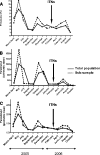Human antibody response to Anopheles gambiae saliva: an immuno-epidemiological biomarker to evaluate the efficacy of insecticide-treated nets in malaria vector control
- PMID: 20595489
- PMCID: PMC2912587
- DOI: 10.4269/ajtmh.2010.09-0684
Human antibody response to Anopheles gambiae saliva: an immuno-epidemiological biomarker to evaluate the efficacy of insecticide-treated nets in malaria vector control
Abstract
For the fight against malaria, the World Health Organization (WHO) has emphasized the need for indicators to evaluate the efficacy of vector-control strategies. This study investigates a potential immunological marker, based on human antibody responses to Anopheles saliva, as a new indicator to evaluate the efficacy of insecticide-treated nets (ITNs). Parasitological, entomological, and immunological assessments were carried out in children and adults from a malaria-endemic region of Angola before and after the introduction of ITNs. Immunoglobulin G (IgG) levels to An. gambiae saliva were positively associated with the intensity of An. gambiae exposure and malaria infection. A significant decrease in the anti-saliva IgG response was observed after the introduction of ITNs, and this was associated with a drop in parasite load. This study represents the first stage in the development of a new indicator to evaluate the efficacy of malaria vector-control strategies, which could apply in other arthropod vector-borne diseases.
Figures




Similar articles
-
The Anopheles gambiae cE5 salivary protein: a sensitive biomarker to evaluate the efficacy of insecticide-treated nets in malaria vector control.Microbes Infect. 2015 Jun;17(6):409-16. doi: 10.1016/j.micinf.2015.01.002. Epub 2015 Jan 28. Microbes Infect. 2015. PMID: 25637950
-
Human antibody responses to the Anopheles salivary gSG6-P1 peptide: a novel tool for evaluating the efficacy of ITNs in malaria vector control.PLoS One. 2010 Dec 14;5(12):e15596. doi: 10.1371/journal.pone.0015596. PLoS One. 2010. PMID: 21179476 Free PMC article.
-
Surveillance of malaria vector population density and biting behaviour in western Kenya.Malar J. 2015 Jun 17;14:244. doi: 10.1186/s12936-015-0763-7. Malar J. 2015. PMID: 26082138 Free PMC article.
-
Current vector control challenges in the fight against malaria.Acta Trop. 2017 Oct;174:91-96. doi: 10.1016/j.actatropica.2017.06.028. Epub 2017 Jul 3. Acta Trop. 2017. PMID: 28684267 Review.
-
Malaria vectors in the Greater Mekong Subregion: overview of malaria vectors and remaining challenges.Southeast Asian J Trop Med Public Health. 2013;44 Suppl 1:73-165; discussion 306-7. Southeast Asian J Trop Med Public Health. 2013. PMID: 24159831 Review.
Cited by
-
IgG responses to the gSG6-P1 salivary peptide for evaluating human exposure to Anopheles bites in urban areas of Dakar region, Sénégal.Malar J. 2012 Mar 16;11:72. doi: 10.1186/1475-2875-11-72. Malar J. 2012. PMID: 22424570 Free PMC article.
-
Anti-triatomine saliva immunoassays for the evaluation of impregnated netting trials against Chagas disease transmission.Int J Parasitol. 2011 May;41(6):591-4. doi: 10.1016/j.ijpara.2011.02.001. Epub 2011 Mar 21. Int J Parasitol. 2011. PMID: 21426907 Free PMC article.
-
Serological evidence of vector and parasite exposure in Southern Ghana: the dynamics of malaria transmission intensity.Parasit Vectors. 2015 Apr 28;8:251. doi: 10.1186/s13071-015-0861-y. Parasit Vectors. 2015. PMID: 25928847 Free PMC article.
-
IgG antibody responses to Anopheles gambiae gSG6-P1 salivary peptide are induced in human populations exposed to secondary malaria vectors in forest areas in Cameroon.PLoS One. 2022 Nov 10;17(11):e0276991. doi: 10.1371/journal.pone.0276991. eCollection 2022. PLoS One. 2022. PMID: 36355922 Free PMC article.
-
Kinetics of Anti-Phlebotomus perniciosus Saliva Antibodies in Experimentally Bitten Mice and Rabbits.PLoS One. 2015 Nov 16;10(11):e0140722. doi: 10.1371/journal.pone.0140722. eCollection 2015. PLoS One. 2015. PMID: 26569103 Free PMC article.
References
-
- WHO-UNICEF World Malaria Report 2005. 2005. www.rollbackmalaria.org Available at. Accessed July 2009.
-
- Maxwell CA, Msuya E, Sudi M, Njunwa KJ, Carneiro IA, Curtis CF. Effect of community-wide use of insecticide-treated nets for 3–4 years on malarial morbidity in Tanzania. Trop Med Int Health. 2002;7:1003–1008. - PubMed
-
- Hawley WA, Phillips-Howard PA, ter Kuile FO, Terlouw DJ, Vulule JM, Ombok M, Nahlen BL, Gimnig JE, Kariuki SK, Kolczak MS, Hightower AW. Community-wide effects of permethrin-treated bed nets on child mortality and malaria morbidity in western Kenya. Am J Trop Med Hyg. 2003;68:121–127. - PubMed
Publication types
MeSH terms
Substances
LinkOut - more resources
Full Text Sources
Other Literature Sources

